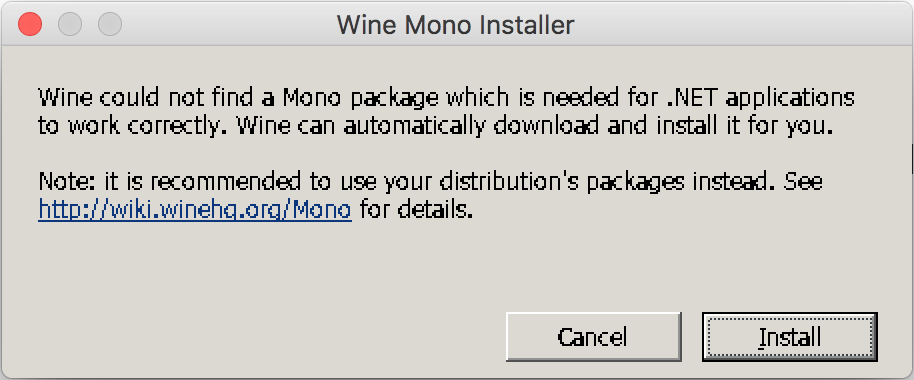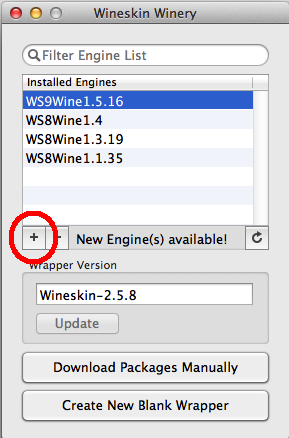Upon first launch, the Configure WINE program will offer to download and install the WINE Mono Installer for.NET support. This isn't necessary for the current version of Kalendis, but it will be in the future, and other Windows apps that you install may need it, so you may as well install Mono. Download the latest Mono release for Mac Run the.pkg file and accept the terms of the license. Mono is now installing: After the installation completed successfully, it’s a good idea to run through the basic hello world examples on this page to verify Mono is working correctly. What I observed was I installed wine and wine-mono: pacman -S wine wine-mono I then expected I'd be able to run a mono binary: wine mydotnetbin.exe But what I encountered was: 0009:err:mscoree:CLRRuntimeInfoGetRuntimeHost Wine Mono is not installed I found that I could manually install mono with the installer, which fixes the issue: wine. Jan 23, 2020 The Mono engine is updated to version 4.9.4, including parts of the Windows Presentation Foundation (WPF) framework. The Gecko and Mono add-ons support shared installation, where the files are used directly from a global location under /usr/share/wine instead of being copied into every new prefix. Internet and networking. I have a problem with Wine and Steam on my Mac. I recently updated to 10.8. When I had Lion Wine and Steam worked perfectly, but because of some problems I had to re-install Wine. The thing is, now that Wine is re-installed, I can't install Steam. First off, when I run the installer the console shows.
News and Updates
May 21, 2021
The Wine development release 6.9 is now available.
What's new in this release:
- WPCAP library converted to PE.
- Support for paper forms in the print spooler.
- More math functions from Musl in the C runtime.
- Various bug fixes.
The source is available now.Binary packages are in the process of being built, and will appear soon at their respective download locations.
May 16, 2021
The Wine Project is selected as a community of OSPP Summer 2021.This is our first time participating in this event. All students who are interested in Wine are welcome! Please have a look for potential proposals you might be interested in: https://wiki.winehq.org/Ospp_Summer_Code. It's great if you have your own idea. Please don't hesitate to post it on the wine-devel mailing list.

The student proposal deadline is June 12th, UTC.
See the OSPP Summer FAQ for more details.
May 7, 2021
Wine Mono Is Not Installed Macos
The Wine development release 6.8 is now available.
Wine Mono Is Not Installed Mac

What's new in this release:
- Libraries installed into architecture-specific subdirectories.
- Secur32 library converted to PE.
- Support for Map object in JavaScript.
- Various bug fixes.
The source is available now.Binary packages are in the process of being built, and will appear soon at their respective download locations.
Recent developments in virtualization, emulation and techniques that allow running of applications developed for “foreign” platforms as if they were native ones, have made it relatively easy, and often free, to use the same app in mixed environments.
This post takes a closer look on one of this techniques, namely Wine (acronym for “Wine Is Not an Emulator”), that allows running native Windows software on POSIX-compliant operating systems, such as Linux, macOS, & BSD, without need for a Windows license.
Here we install the game on macOS Sierra / High Sierra (the screenshots are from Sierra).

- First you need to allow your system to install apps from “App Store and identified developers” (or possibly “Anyone”, depending on what else needs to be installed other than XQuartz and Wine). Earlier macOS versions let you alter the default setting (that allows apps only from the App Store) by setting the Gatekeeper option under System Preferences > Security & Privacy > General, but High Sierra hides the other two options and you need to enable them by opening the Terminal (in Finder, click Go > Utilities and open Terminal), and type the following (you need to enter your user password to be able to change the setting):
- After this you can go and change the Gatekeeper setting.
- Go to https://www.winehq.org and read the introductory text, if you are not familiar with the concept of Wine, then go to https://wiki.winehq.org/MacOS to read installation instructions specific to macOS.
- You first need to have XQuartz 2.7.7. (or later) installed. Visit https://www.xquartz.org to download it. Click the .pkg file in Downloads to mount the installer, then launch it to go through the installation.
- After having installed XQuartz, download Wine at https://dl.winehq.org/wine-builds/macosx/download.html (version 2.21 “Wine Staging” is a good choice):
- Download the .pkg file, click it in Downloads to mount the installer, then launch it to start the installation. During the installation, you may be interrupted by prompts to install support for Mono (for .NET applications) and Gecko (for apps that use HTML internally). Accept to install these support packages.
- After the installation is complete, you can go to http://www.4windsmj.com/downloads01.htm and download the latest version of Four Winds Mah Jong. Once downloaded, click the executable setup package (normally 4W2Full24.exe) in Downloads. It will automatically be launched in Wine and installed in correct location. A Windows shortcut is placed on the desktop, but it naturally does not work. You need to replace it with a Mac alias.
- Open your Home folder (in Finder, click Go > Home or press Cmd+Shift+H). Now make hidden files and folders visible by pressing Cmd+Shift+. (dot). This shows the hidden .wine folder where your Windows environment is installed:
- Double click the .wine folder and open folders until you have 4Winds2 folder open (the folder path relative to .wine is, as shown in the image below: drive_c > Program Files > 4Winds2:
- Here, click with the secondary mouse button on 4Winds2.exe to create an alias, then drag and drop it on your desktop.
- Launch Four Winds by double clicking the alias.
- Once launched, go to File > Preferences, and under User Interface > General option page (accessed by the category tree on the left), disable color management by clearing the check mark from the Use color management option:
You may also need to Bypass DirectX sound (under the same option page), and choose a MIDI file (on the Themes option page) for the “Background” and “Win of the game” music, or set their values to “none”. (the default music comes as .mp3 files which require DirectX). If you do not change the sound settings, you can turn off background music from the Options menu so that an unsupported feature is not used.
- If you have a one-button mouse, click the Game Controls button, then change the mouse control setting for discarding from “Right click on raised tile” to “Click on raised tile”. On the same dialog box, you may need to uncheck Use custom cursors (with recent Wine builds, animated and custom cursors seem to be working fine, but if the game suddenly freezes, one possible cause is the use of custom mouse cursors).
- Close the Preferences dialog box and click Help > Register to enter your registration name and number. Then choose Game > New Game to start a new game with preferred rules.
- You may want to test with different game boards by using the options under the View > Game boards sub menu to find the board size and layout that works best on your screen. Note that the quality of graphics is mediocre compared to the original but looks slightly better on boards that have not been scaled. If you choose a 24-bit theme, scaling has a better quality: e.g., for the default graphics, choose File > Preferences, then under User Interface > Themes, choose “Four Winds (24-bit)”.
And there you are, running Four Winds Mah Jong on your Mac, without needing a Windows license. The quality is not as good as when using VMWare or VirtualBox (both free), or Parallels Desktop, not to mention running the game on real Windows on a BootCamp partition, but at least you can now play proper Mahjong with multitude of rule options offline on your Mac.
NOTE: WINE based solutions are currently limited to macOS versions that support running 32-bit apps, so this solution is not applicable to macOS Catalina or Big Sur. We are considering release of a 64-bit version build of Four Winds at the time WINE is again supported on modern macOS operating systems.
A screenshot of Four Winds 2.18 running on macOS Mojave using the latest Wine (4.2 Staging) and XQuartz 2.7.11.
The quality of graphics has improved with latest versions and scaled boards work well.
Running Four Winds on Linux
The procedure is basically the same as on macOS, though installation happens from within the Terminal. WineHQ has instructions for installing Wine on several different Linux systems. Below is a screenshot of Four Winds running on Ubuntu 16.04 using Wine 3.0.